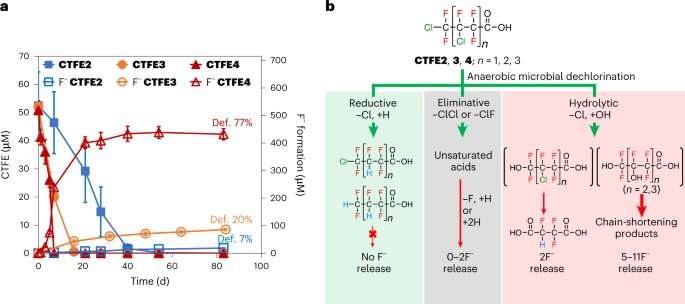May 19, 2023 report
Using microbial degradation to break down chlorinated PFAS in wastewater

Bob Yirka
news contributor

A team of chemical and environmental engineers at the University of California, Riverside, has found a way to use microbial degradation to break down chlorinated PFAS in wastewater. In their paper published in the journal Nature Water, the group describes how they tested the ability of microbes in waste water to degrade some PFAS compounds and what they found by doing so.
Chlorinated polyfluorocarboxylic acids (PFAS) are a group of man-made chemicals that have been widely used in industrial processing for several decades. In recent times they have become known as "forever chemicals" because they break down so slowly in the environment鈥攊t has also been found that they can build up in the bodies of animals, including humans.
High levels of PFAS in the body have been linked to multiple adverse health effects, such as liver damage, cancer, immune system disorders, and developmental problems. Such problems have led scientists to look for ways to break down PFAS in ways that can be done on an industrial scale. One such approach has involved the use of light-powered catalysts while another has involved the use of reagents. In this new effort, the researchers have taken an entirely different approach鈥攗sing microbes to break them down.
The work by the team involved studying samples of activated sludge鈥攎aterial that is created as part of the process of treating human waste鈥攖hat might hold microbes able to break apart PFAS. In so doing, they found two kinds of anaerobic bacteria that appeared ripe for testing.
After isolating multiple specimens, the research team exposed them to PFAS samples and then watched to see what would happen. They found that both types of bacteria were able to conduct reductive hydrolytic and eliminative dichlorination鈥攚hich is generally a first step toward de-fluorinating PFAS.
Continued study of the microbes showed they were also capable of partially de-fluorinating some types of PFAS. These findings suggested that it might be possible to use bacteria as part of a process involved in breaking down PFAS. The researchers suggest that the reason the bacteria acted on the PFAS was that they found they could be used as a source of carbon and energy. The team also found that the bacteria were able to transfer genes that encoded for the degradation of enzymes present in PFAS.
The research team plans to continue testing the bacteria to see if they can develop a process for growing them in an environment that allows for breaking down PFAS鈥攐ne that would be both efficient and safe.
Written for you by our author 鈥攖his article is the result of careful human work. We rely on readers like you to keep independent science journalism alive. If this reporting matters to you, please consider a (especially monthly). You'll get an ad-free account as a thank-you.
More information: Bosen Jin et al, Substantial defluorination of polychlorofluorocarboxylic acids triggered by anaerobic microbial hydrolytic dechlorination, Nature Water (2023).
Journal information: Nature Water
漏 2023 Science X Network




















